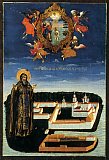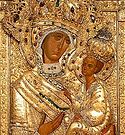

| Previous day | Next day |
| Old Style
June 26
|
Thursday |
New Style
July 9
|
|
5th Week after Pentecost.
Tone 3.
Fast of the Holy Apostles. |
Fish, wine and oil allowed.
|
![]() Appearance of the Tikhvin Icon of the Most Holy Theotokos (1383).
Appearance of the Tikhvin Icon of the Most Holy Theotokos (1383). ![]() St. David of Thessalonica (540).
St. David of Thessalonica (540).
St. John, bishop of Gothia in the Crimea (ca. 800). St. Dionysius, archbishop of Suzdal (1385). Uncovering of the relics of St. Tikhon of Lukhov (1569). Translation of the relics of St. Nilus of Stolobny (1995).
Icon of the Most Holy Theotokos “Of Lydda” (1st c.) Icon of the Mother of God “Neamts” (1399). and “Of the Seven Lakes” (Kazan) (17th c.).
St. Brannock (Brynach) of Braunton, England (6th c.). Martyr Pelagius of Cordoba (925). New Martyr David of St. Anne’s Skete, Mt. Athos, at Thessalonica (1813).
Thoughts for Each Day of the Year
According to the Daily Church Readings from the Word of God
By St. Theophan the Recluse

Thursday. [Rom. 15:17-29; Matt. 12:46-13:3]
For whosoever shall do the will of My Father which is in Heaven, the same is My brother, and sister, and mother. By this the Lord gives us to know that the spiritual kinship which He came to plant and raise up on the earth is not the same as fleshly kinship; although in the form of its relationships, the spiritual is the same as the fleshly. The spiritual also contains fathers and mothers—they are those who give birth to people with the word of truth or the gospel, as the apostle Paul says. And it contains also brothers and sisters—they are those who are born spiritually from one person and grow in one spirit. The connection between [spiritual] relatives is founded on the action of grace. It is not external, not superficial, but as deep and alive as the fleshly connection, only it has its place in another much higher and important sphere. This is why it predominates over the fleshly, and when necessary, it brings the fleshly as a sacrifice to its spiritual interests without regret, in full certainty that this sacrifice is pleasing to God and is required by Him.
Articles
 Appearance of the Tikhvin Icon of the Mother of God |
 St David of Thessaloniki |
 St Dionysius the Archbishop of Suzdal |
 Venerable Tikhon of Luchov, KostromaSt Tikhon of Lukh, and Kostroma (in the world Timothy), was born within the bounds of the Lithuanian princedom and was in military service there. |
 Icon of the Mother of God of Seven LakesThe “Seven Lakes” Icon of the Most Holy Theotokos shone forth with many miracles in the seventeenth century in the area of Kazan. |






